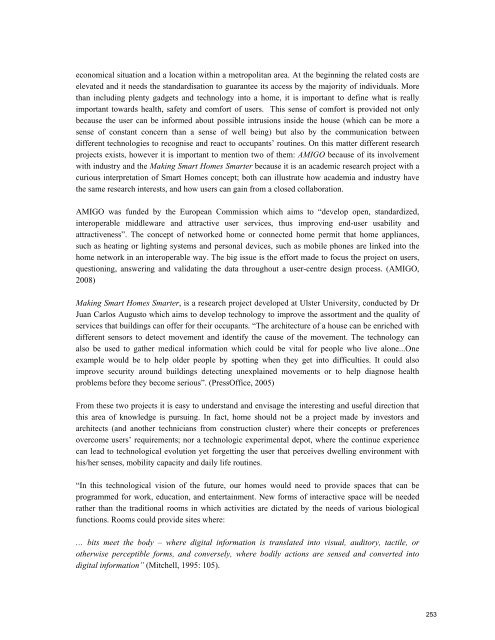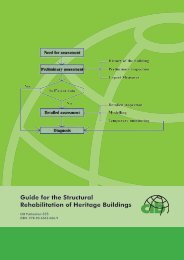CIB W116âSmart and Sustainable Built Environments - Test Input
CIB W116âSmart and Sustainable Built Environments - Test Input
CIB W116âSmart and Sustainable Built Environments - Test Input
Create successful ePaper yourself
Turn your PDF publications into a flip-book with our unique Google optimized e-Paper software.
economical situation <strong>and</strong> a location within a metropolitan area. At the beginning the related costs are<br />
elevated <strong>and</strong> it needs the st<strong>and</strong>ardisation to guarantee its access by the majority of individuals. More<br />
than including plenty gadgets <strong>and</strong> technology into a home, it is important to define what is really<br />
important towards health, safety <strong>and</strong> comfort of users. This sense of comfort is provided not only<br />
because the user can be informed about possible intrusions inside the house (which can be more a<br />
sense of constant concern than a sense of well being) but also by the communication between<br />
different technologies to recognise <strong>and</strong> react to occupants’ routines. On this matter different research<br />
projects exists, however it is important to mention two of them: AMIGO because of its involvement<br />
with industry <strong>and</strong> the Making Smart Homes Smarter because it is an academic research project with a<br />
curious interpretation of Smart Homes concept; both can illustrate how academia <strong>and</strong> industry have<br />
the same research interests, <strong>and</strong> how users can gain from a closed collaboration.<br />
AMIGO was funded by the European Commission which aims to “develop open, st<strong>and</strong>ardized,<br />
interoperable middleware <strong>and</strong> attractive user services, thus improving end-user usability <strong>and</strong><br />
attractiveness”. The concept of networked home or connected home permit that home appliances,<br />
such as heating or lighting systems <strong>and</strong> personal devices, such as mobile phones are linked into the<br />
home network in an interoperable way. The big issue is the effort made to focus the project on users,<br />
questioning, answering <strong>and</strong> validating the data throughout a user-centre design process. (AMIGO,<br />
2008)<br />
Making Smart Homes Smarter, is a research project developed at Ulster University, conducted by Dr<br />
Juan Carlos Augusto which aims to develop technology to improve the assortment <strong>and</strong> the quality of<br />
services that buildings can offer for their occupants. “The architecture of a house can be enriched with<br />
different sensors to detect movement <strong>and</strong> identify the cause of the movement. The technology can<br />
also be used to gather medical information which could be vital for people who live alone...One<br />
example would be to help older people by spotting when they get into difficulties. It could also<br />
improve security around buildings detecting unexplained movements or to help diagnose health<br />
problems before they become serious”. (PressOffice, 2005)<br />
From these two projects it is easy to underst<strong>and</strong> <strong>and</strong> envisage the interesting <strong>and</strong> useful direction that<br />
this area of knowledge is pursuing. In fact, home should not be a project made by investors <strong>and</strong><br />
architects (<strong>and</strong> another technicians from construction cluster) where their concepts or preferences<br />
overcome users’ requirements; nor a technologic experimental depot, where the continue experience<br />
can lead to technological evolution yet forgetting the user that perceives dwelling environment with<br />
his/her senses, mobility capacity <strong>and</strong> daily life routines.<br />
“In this technological vision of the future, our homes would need to provide spaces that can be<br />
programmed for work, education, <strong>and</strong> entertainment. New forms of interactive space will be needed<br />
rather than the traditional rooms in which activities are dictated by the needs of various biological<br />
functions. Rooms could provide sites where:<br />
… bits meet the body – where digital information is translated into visual, auditory, tactile, or<br />
otherwise perceptible forms, <strong>and</strong> conversely, where bodily actions are sensed <strong>and</strong> converted into<br />
digital information” (Mitchell, 1995: 105).<br />
253

















